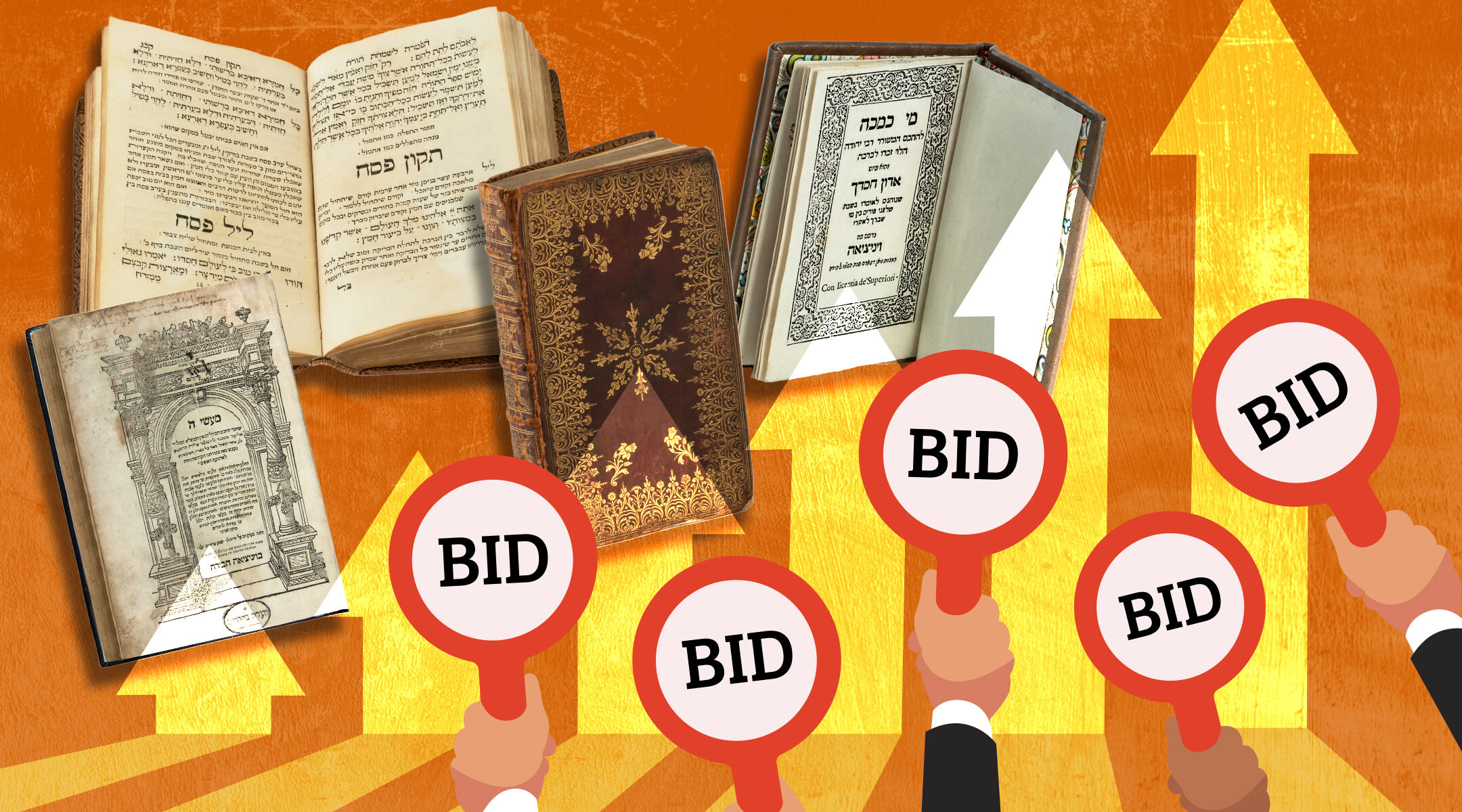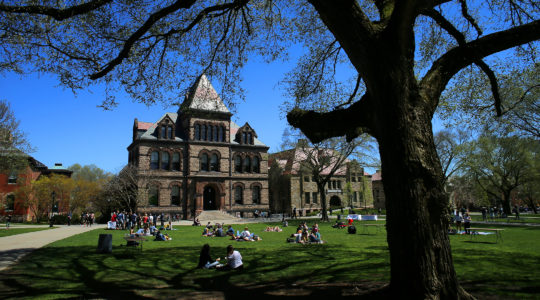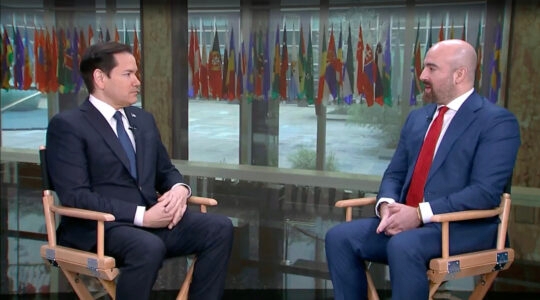(JTA) – Israel Mizrahi joined dozens of fellow connoisseurs of rare Jewish books last December to watch the livestream of Genazym, the hottest auction house in the market. A bookdealer by trade, Mizrahi was also on the phone being paid to advise a wealthy client who had signed up to make bids.
But as the auction proceeded, Mizrahi’s advice had little use. His trigger-happy client didn’t seem to care about established valuations: He ended up paying about $50,000 for a book estimated at half that price. “He just pressed the button and kept on bidding until the bidding was over,” Mizrahi said. “There was no convincing him out of it. He spent nearly $600,000 that day and there was no sense to it.”
Behavior that confounds veterans of the rare Jewish book market has become routine at auctions organized by Genazym.
Mizrahi recalled the sale in 2021 of a Passover Haggadah printed in the 1920s in Vienna. With attractive illustrations of a prominent 19th-century rabbi named Moses Sofer and his family, the book makes for a nice addition to a collection. It also happens to be very common.
“I sell copies for $100, and I have probably sold 150 copies in my life,” said Mizrahi, whose shop in Brooklyn is a mecca for Jewish book lovers. “It sold for about $5,500 at Genazym’s auction. I currently have it on sale still for $100.”
At the highest end of sale prices, a 16th-century first-edition Shulchan Aruch, a book of Jewish law, commanded $620,000 at a Genazym auction last September, while a copy of Noam Elimelech, a classic rabbinic treatise, printed in 1788, fetched $1.4 million four months later — in both cases at least doubling or tripling what experts thought the items were worth based on past sales of the same texts.
“Genazym has come on like a freight train into the world of Jewish auctions. Some of the prices realized are far beyond what this market has seen before,” said David Wachtel, the former Judaica consultant for Sotheby’s auction house.
Since Genazym’s first auction in 2017, it has sold some 1,900 books, manuscripts and other collectible documents for about $26 million plus commission, roughly $12 million above total starting prices, according to an analysis by the Jewish Telegraphic Agency of auction records on Genazym’s website. Genazym has increasingly outperformed the longest-standing Judaica auction firms in New York and Jerusalem.

A page from an illustrated Passover haggadah printed in Vienna in the 1920s. (Courtesy of Genazym)
It’s hard to tell exactly what’s driving the boom because the identity of Genazym’s customers is confidential and few flaunt their collections widely. One of the auction house’s owners, in a rare public comment, ventured that Jewish buyers are craving a connection with their heritage. What’s clear is that at a time when traditional libraries are cutting back on buying Jewish texts, Genazym is tapping into an emerging luxury market among Orthodox Jews — and fueling the rise of religious texts as both a status symbol and investment vehicle in some communities.
“I know the sellers, the customers and everybody involved and there is a new wealthy class of Orthodox Jews that have a limited range of things they can splurge on,” Mizrahi said. “They don’t go to Vegas, they don’t do crazy vacations. They keep kosher. So this is a way that they can splurge and show off.”
Rabbi Pini Dunner, who collects rare Jewish books, said investing in Judaica is likely attractive for some in the Hasidic community, whose religious observance is stricter than that of congregants at his Modern Orthodox synagogue in the Los Angeles area.
“There are people I know here in Beverly Hills who’ve got car collections worth tens of millions of dollars,” Dunner said. “In the Hasidic world that has no currency, just as the wow factor of a Picasso has no currency. An original manuscript or first-edition of the Noam Elimelech has a real wow factor, particularly if you can tell people the book sold for more than a million dollars at a Genazym auction.”
The impression that the Hasidic world has grown wealthier over the last decade or two is widespread and based, at least in part, on the proliferation of luxury products and services tailored for the community in places like Lakewood, New Jersey, and Kiryas Joel, New York. Weddings have become increasingly expensive and elaborate, fine dining options are common, and high-end kosher wine and liquor are more readily available.
“It wasn’t that long ago that sit-down dining was looked down upon or not even available. Now there are a plethora of options,” said Chaim Saiman, a law professor at Villanova University who studies the intersection of commerce and Jewish law. “It’s no secret that $200 bottles of Scotch appear at kiddush clubs all the time. $50 used to be a big deal, then $100 was a big deal, now we are at $200.”
Where the new wealth is coming from is not totally clear. Limited survey and U.S. Census data suggests that Orthodox Jews feel crunched by costs associated with practicing religion and that there are large pockets of poverty among them, particularly in Hasidic communities, according to Mark Trencher, the founder of Nishma Research, a nonprofit dedicated to studying the Orthodox Jewish community. The prevalence of large families also means that generational wealth can be harder to accrue for Orthodox Jews.
But there have always been high earners whose philanthropy has buttressed their communities, Trencher noted. “There are a lot of people in that community that are very successful in their businesses and they have large amounts of wealth,” he said. “Those people generally are huge donors to charities. From a financial perspective, those communities are probably doing much better than you would expect them to.”
Many of those high earners make their money through entrepreneurship rather than professional success in the white-collar world. Many nursing home chains — an industry valued at an estimated $171 billion and where growth is expected — have Orthodox owners. Amazon has also created new opportunities for Orthodox businessmen. Orthodox landlords, meanwhile, have benefited from skyrocketing real estate prices in places like Williamsburg, Brooklyn.

A page from a 16th-century first-edition Shulchan Aruch, a book of Jewish law, which fetched $620,000 at a Genazym auction. (Courtesy of Genazym).
Recent reporting in The New York Times about the Hasidic education system has provided a window into another stream of revenue for private businesses in the community. Entrepreneurs in the community have responded to the increased availability of government funding for special education in New York in recent years by establishing companies to service Hasidic schools, with the government footing the bill. In one example highlighted by the Times, a married Hasidic couple opened such a business in 2014 when they were 21 and 19 years old; in 2022, their company received more than $38 million in government funding.
The owners of another set of companies providing services to Hasidic schools appear to have used their windfall to purchase rare books through Genazym. The owners were indicted in January for allegedly billing the government for more than $1 million in childcare services that they never provided and otherwise defrauding the government out of more than $2.8 million.
Prosecutors are seeking to have the alleged fraudsters forfeit seven books and other documents as listed in a federal indictment. They include manuscripts with a rabbinic signature and rare books of blessing and Jewish law, all of which match items listed on Genazym auctions, where they sold for a total of about $274,000.
Buying Jewish texts at auction can seem like a savvy investment for buyers seeking to safeguard or grow their wealth. Before Genazym launched, a typical Genazym buyer might have invested in U.S. Treasury bills or the stock market, according to Wachtel, the former Sotheby’s consultant.
“I think Genazym has been able to convince people that this is a good vehicle for establishing and growing wealth,” he said. “That also dovetails with your ability to, let’s face it, show off. Somebody comes to your house, you can show them a first-edition Shulchan Aruch. But you’re not going to say, hey, come look at my T-bills.”
The auction house’s tactics appear tailor-made for this growing market. Its motto is “Own your heritage,” and it’s printed on the catalogs the company distributes through popular Orthodox magazines like Ami or Mishpacha or podcasts, places where people with no prior interest in books might encounter the hype. The catalogs also appear in synagogues in heavily Hasidic areas like Brooklyn or Lakewood, but without the prices printed on them so as not to violate a Jewish prohibition against discussing financial matters on Shabbat.
The descriptions in the catalogs emphasize links between the items for sale and notable rabbis from history, especially figures who established rabbinic dynasties that continue to exist today and who are revered by yeshiva-educated Orthodox Jews. The link might be a signature of a rabbi in a ledger from an old fundraising tour that took place 200 years ago. Or it might be that an important rabbi owned the book in question or even prayed out of it. Like a pair of pants of a prominent Israeli rabbi that drew widespread attention when they briefly went up for auction last month, these texts are seen by some as conferring holiness onto those who possess them. By virtue of their pedigree, these artifacts might even be seen as a segula, or Jewish protective charm.
In its promotional materials and live auctions, Genazym also uses more colloquial and hyperbolic language to describe its items than traditional auction houses, which tend to stick to the kind of terminology used by academic scholars.
“Genazym found a formula to make books and manuscripts really exciting for the layperson, especially in the Orthodox community,” said Yoel Finkelman, a former curator of the Judaica Collection at the National Library of Israel. “They are not using the vocabulary of experts, they’re using plain ordinary language, like ‘very old’ or ‘very rare.’ No one at Sotheby’s would ever refer even to a thousand-year-old book that way.”
Genazym’s unique approach extends to the delivery of items to buyers. A traditional buyer in the rare Jewish book market, like Michelle Margolis, Columbia University’s Jewish studies librarian, might only care that the book they bought is safely delivered. But with Genazym, the books come wrapped in a proper clamshell and velvet bag. “I rolled my eyes when my delivery arrived, but at the same time that’s a lot of investment,” Margolis said, adding that many other auction houses have been cutting costs, for example, by doing away with their customary printed catalogs.
Jacob Djmal, who lives in Brooklyn, has dabbled in Judaica collecting for many years, an interest he picked up from his grandfather. He remembers suddenly seeing Genazym’s advertising everywhere. “They started reaching out to you in every way possible, finding a demographic that wasn’t aware before. Every Genazym auction I have people texting me — ‘Did you hear about this? Did you hear about that?’ — as if something is happening that had never happened before.”
Sometimes, that is true. A breakout moment came during the December auction, when Genazym cleared $4.4 million in sales, about $2.6 million above total starting prices.
“If there was any doubt that Genazym were now the most commercially remarkable rare book auction house on Earth, the results of their latest Judaica auction this week put paid to that: essentially almost every lot sold for at least twice [the estimated amount],” a major British book collector living in France said on his anonymous Twitter account, which has around 110,000 followers, in December.
It remains to be seen whether Genazym can challenge Sotheby’s Judaica division as the destination for sellers with the rarest and most valuable books. Last year, a medieval prayer book sold for $8.3 million at Sotheby’s and this year, the New York auction house is accepting bids for the oldest known copy of the Hebrew Bible, which is expected to fetch as much as $50 million.
But Djmal considers especially remarkable about Genazym is not just the high prices but also the way in which rare books have caught on among Orthodox youth as something cool. “My son and his friends in yeshiva are talking about these items,” Djmal said. “These books represent rabbis they have heard about from a young age.”
The team behind Genazym’s success is led by three brothers from the Stefansky family who live in Jerusalem and New York. Before starting an auction house they worked for many years as private dealers in the rare book market. Their names, Chaim, Moshe and Bezalel, rarely appear anywhere and they almost never grant interviews. Chaim Stefansky made an exception for the Jewish Telegraphic Agency and requested that this article not put him in the spotlight nor portray Genazym’s success as a product of his business acumen.
Stefansky said Genazym has tapped into a universal and deep-seated desire of people to strengthen their identities by connecting with the past. The Jewish community, he said, has been poorly served by an emphasis on historical and even current persecution.
“Always, we are victimized and we cry,” Stefansky said. “What we have in common maybe is that your grandmother and my grandmother were sharing the same bed in Auschwitz. Give me something positive of my past to be proud of. Your heritage has not only sorrow but also a happy, rich, and huge intellectual tradition. So Genazym comes and tells people about their heritage. It’s yours. It belongs to you.”
He said the same thing can be done with any ethnic or religious group.
“If you go to the Irish community and press the right buttons in terms of what you know that every Irish person is extremely proud of, I think you’ll be very successful,” Stefansky said.
He rejected the impression that Genazym’s buyers come primarily from the ranks of the nouveau riche in the Hasidic world.
“It’s coming from all sections,” Stefansky said. “People will say that there’s a lot of fresh money in the market. But we also have very good old money. We have institutions. And, also, the regular man. Mostly, the regular man, who never knew he could have access to any of this.”
One of the only customers who agreed to be identified and interviewed for this article is Rick Probstein, who says he’s spent more than $100,000 at the company’s auctions. He can’t remember when he started seeing Genazym catalogs but he had never collected Judaica before, which is perhaps surprising given that he’s an Orthodox Jew who’s been working in the collectibles business since he was a child trading baseball cards.
Today, at 53, Probstein is one of the largest sellers of sports collectibles in the world, operating through a dedicated account on eBay. “I run a humongous business — I am doing something like $160 million a year,” he said of his sales volume.
Probstein, who lives in Passaic, New Jersey, had long felt a pang of guilt about the lack of Jewish content in his collection. “I collect things but what do I have of my own heritage?” he recalled thinking to himself. “So when I started getting the catalogs, I said, ‘I gotta be a good Jew.’ I started bidding on things and I got really into it.”
Once Probstein got started, the Stefansky brothers began checking in on him, providing concierge service and cultivating him as a client.
“This is a boutique run by a Jewish family with a personal touch,” Probstein said “They call me on the phone, saying, ‘Rick, did you get the catalog? What did you think? Here are some items that you could really like.’”
Bidding on Genayzm items is not purely sentimental for Probstein. “I’m putting real money into it because I think that from an investment standpoint, it has a lot of upside,” he said.
Still, the items he buys tend to have personal significance.
“I am partial to items relating to the Chofetz Chaim,” Probstein said, referring to the rabbi and Jewish scholar Yisrael Meir Kagan, who died in 1933. Probstein’s oldest son is named Yisrael Meir in his honor. The Chofetz Chaim also appeals to Probstein because of his writings about lashon hara, the prohibition in Jewish law against speaking evil of people. “I think that speech is important and he’s sort of the embodiment of that,” Probstein said.
Genazym has sold six letters and a handwritten blessing signed or written by the Chofetz Chaim at prices ranging from about $16,000 to $68,000.
Ever since Probstein started collecting Judaica, these items have served as a draw for family and friends visiting his home.
“People in my community that come over for kiddush [refreshments after Shabbat service] know that I have this stuff and they always want to see it,” Probstein said. “Nobody ever looks at my sports memorabilia collection because it’s in my office but my Judaica stuff is in my house. They look at the letters and talk about the historical context. People love it.”
The revelation that so many Jews appear fascinated with their own history and want to engage with scholarly tradition comes at a time when many Jewish libraries have been struggling.
The library of the Jewish Theological Seminary in Manhattan, which has the most comprehensive and significant collection of Jewish books outside of Israel, has seen its footprint downsized amid budget cuts at the Conservative movement seminary. Also under financial pressure, American Jewish University was forced to sell its Bel Air campus in Los Angeles, which housed a library. Hebrew Union College, meanwhile, opted to end its Reform rabbinical training program in Cincinnati and even though the campus library has survived the cuts, financial uncertainty remains.
Genazym’s populist approach might hold lessons for Jewish institutions and university libraries with significant Judaica collections that hope to engage the public around books.
“The lesson is to lay off the snobbery a little bit,” said Finkelman, the former Judaica curator at the National Library of Israel, which is slated to reopen in a new and more accessible space later this year. “The goal of public institutions is to enable preservation but also to enable public access and public education. There are great stories in books and archives.”
Finkleman said he has encountered sneering reactions to the way Genazym promotes books, and they are similar to the response in the United States when the pop star Lizzo played a crystal flute that belonged to James Madison on stage at the Library of Congress.
“There are echoes of the same thing here,” he said. “Get out of the snobby ivory tower and realize you are preserving history for people.”
JTA has documented Jewish history in real-time for over a century. Keep our journalism strong by joining us in supporting independent, award-winning reporting.






